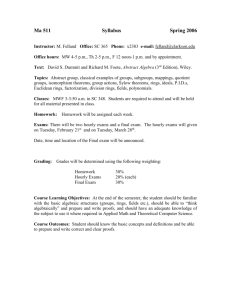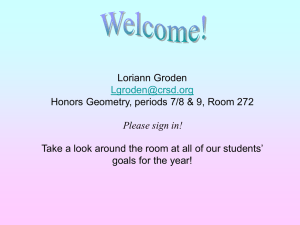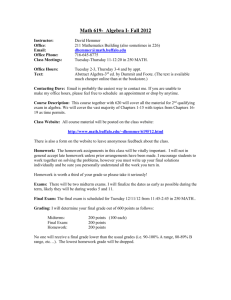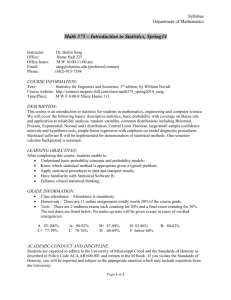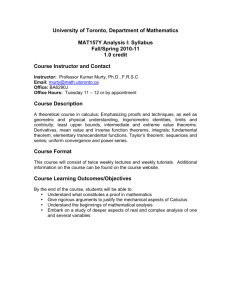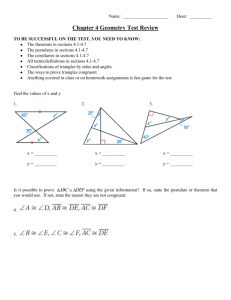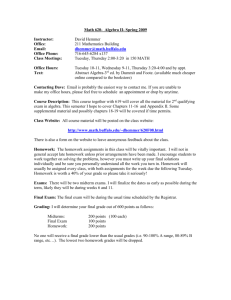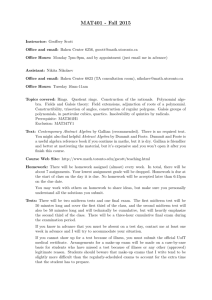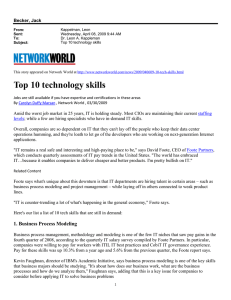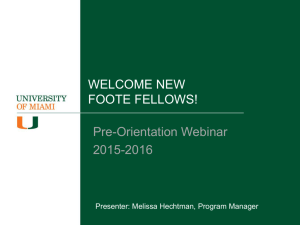Math 113, Abstract Algebra
advertisement
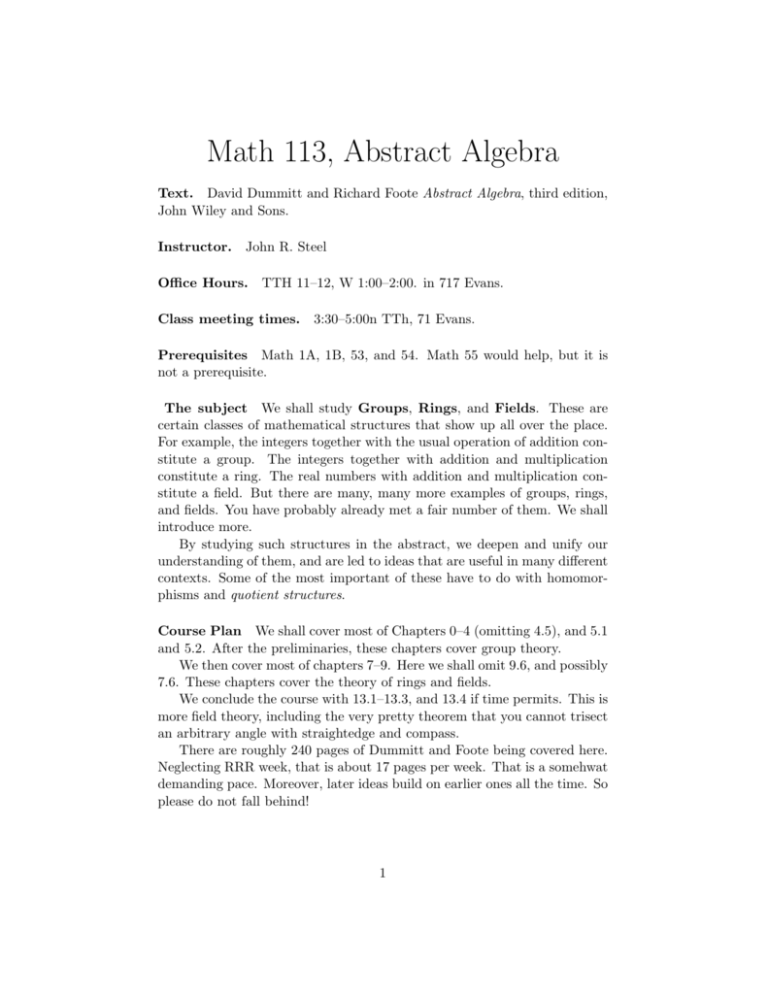
Math 113, Abstract Algebra Text. David Dummitt and Richard Foote Abstract Algebra, third edition, John Wiley and Sons. Instructor. John R. Steel Office Hours. TTH 11–12, W 1:00–2:00. in 717 Evans. Class meeting times. 3:30–5:00n TTh, 71 Evans. Prerequisites Math 1A, 1B, 53, and 54. Math 55 would help, but it is not a prerequisite. The subject We shall study Groups, Rings, and Fields. These are certain classes of mathematical structures that show up all over the place. For example, the integers together with the usual operation of addition constitute a group. The integers together with addition and multiplication constitute a ring. The real numbers with addition and multiplication constitute a field. But there are many, many more examples of groups, rings, and fields. You have probably already met a fair number of them. We shall introduce more. By studying such structures in the abstract, we deepen and unify our understanding of them, and are led to ideas that are useful in many different contexts. Some of the most important of these have to do with homomorphisms and quotient structures. Course Plan We shall cover most of Chapters 0–4 (omitting 4.5), and 5.1 and 5.2. After the preliminaries, these chapters cover group theory. We then cover most of chapters 7–9. Here we shall omit 9.6, and possibly 7.6. These chapters cover the theory of rings and fields. We conclude the course with 13.1–13.3, and 13.4 if time permits. This is more field theory, including the very pretty theorem that you cannot trisect an arbitrary angle with straightedge and compass. There are roughly 240 pages of Dummitt and Foote being covered here. Neglecting RRR week, that is about 17 pages per week. That is a somehwat demanding pace. Moreover, later ideas build on earlier ones all the time. So please do not fall behind! 1 Homework. Homework will be assigned weekly. The assignments will announced at lecture, and posted on the web at http://math.berkeley.edu/~steel/courses/Courses.html Those homework announcements will also tell you where we are in lecture, and what you should be reading. Most of the homework will be assigned from Dummitt and Foote. You can find solutions to all the Dummitt and Foote exercises written out online. The right way to use this fact is to work hard on the problems on your own, and if you are really stuck, take a look at the online solution for a hint, then resume work on your own. Rinse and repeat. When you have a solution at last, compare it to the one online. Are they the same? Maybe not on the surface, but when you look deeper? Of course, the wrong way is just to copy mindlessly. In a similar vein, I encourage you to talk to your classmates and others about the course material, including the homework problems. The right way to do it is to do as much as you can on your own, and use your conversations to strengthen your grasp of the material. Homework will count for 20 percent of your grade. Formally, I ask only that you write out your solutions neatly, carefully, and in your own words. But I do hope you will do it the right way. That way you’ll do better on the exams, and get more out of the course. Exams There will be two midterms, the first one on either Sept. 30 or Oct. 2, and the second one probably on Nov. 6. I will announce the exact dates for each midterm at least 2 weeks in advance. The first midterm will probably cover the course material up through section 3.1. The second midterm will probably cover the course material through section 7.5. Again, I will announce definitely what is to be covered at least 2 weeks in advance. There will be a written final exam as well. Grading Homework counts 20%, and each midterm counts 20%. The final counts for the remaining 40%. I will use a curve to help me assign grades. The text There is a lot of material in Dummitt and Foote, much of it presented in condensed fashion. The text presents many examples of the concepts and theorems introduced, and works through some of them quite quickly. It is a book that demands that you read slowly, and stay actively engaged, working through the points that are only explained quickly. 2 There are many exercises at the end of each section. I think they are pretty good ... at the right level to really help you understand things. I can only assign a small percentage as homework to be turned in, but I hope you will do many more on your own. Whether you can do the exercises is the best test of whether you understand the material. Study tips In my lectures I shall give the main definitions, examples, theorems, and proofs, along with what I hope will be intuitive explanations which glue them all together. This is a course in “real”, rigorous mathematics; students will be asked to know the exact statements of the main definitions and theorems, how to prove the main theorems, and to be able to find and present simpler proofs on their own. One important way to deal with abstract concepts is to generate lots of examples on your own. When you see a theorem, ask yourself why its hypotheses are there ... are there counterexamples if you drop one of them? Another way to deal with them is to memorize all the main definitions, theorems, and proofs, in an exact form. It’s not enough to carry them around in your book, you need to carry them around in your head, so that you can use them when you think. Moreover, the process of memorization forces you to understand things better, because it is pretty hard to memorize something you don’t understand at all. Finally, when you read a proof or solve an exercise problem, try to summarize for yourself the main ideas in some memorable form. It’s not enough just to struggle to the end, you need to take something away with you! TA. There will be one GSI for all of the sections of 113. His name is Jason Ferguson. He will hold 10 office hours per week, time and place to be announced soon. There’s nothing like working through some problems with someone providing hints or explanations and elaborations as you go. For that reason, I strongly encourage you to come to my office hour, or go to Jason Ferguson’s, or both. Course web site. Course information and homework assignments will be available online at http://math.berkeley.edu/~steel/courses/Courses.html 3
